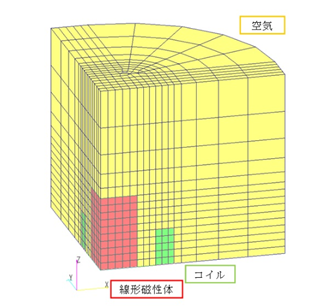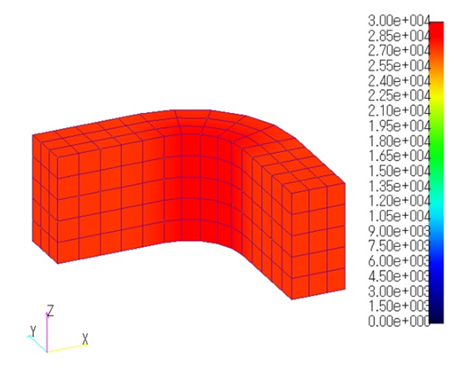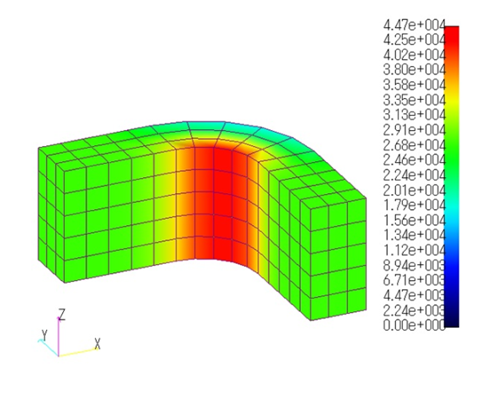Heat generation output of current magnetic field sources
- TOP >
- Analysis Examples by Functions (List) >
- Heat generation output of current magnetic field sources
Summary
Current field sources used as coils have been outputting current distribution except for "COIL (external current field source)". This time, we have extended the output to include the amount of heat generation when the conductivity is set. This section introduces the details.
Explanation
As a simple model, we use the IEEJ static magnetic field validation model, which shown in Fig. 1, and is also used in "Static magnetic field analysis using ELMCUR (element current source)", to check the heat generation and coil resistance when various current field sources are used. A DC current of 1A is applied to 3000T, and the static magnetic field analysis is performed with a conductivity of 5e+007$S/m$.
Table 1 shows the amount of heat generated in the mesh area by various current field sources. Since 1 A is applied, the resistance value is equal to the heat generation value $(R=Q/I^2)$. The resistance calculated by EMSolution and output to the output file is multiplied by REGION_FACTOR of CIRCUIT, so the value divided by REGION_FACTOR is also shown for reference. It can be verified that the two values are, as a matter of course, identical for various current field sources. "ELMCUR" and "SDEFCOIL" are the magnetic field sources that can distribute the current uniformly across the coil cross-section, so the results are expected to be in close agreement. "PHICOIL" and "DCCURR" are exactly the same calculations because the conditions are identical. Comparing the results between the current field sources, the ELMCUR and SDEFCOIL results are almost identical and the PHICOIL and DCCURR results are identical, although there are some differences.
We have also output the heat generation value of the current magnetic field source in the heat post file (HEAT). Fig. 2(a) and (b) show the heat generation density distribution for SDEFCOIL and PHICOIL, respectively. In SDEFCOIL, the heat generation density is constant because the current density is constant, while in PHICOL, the heat generation density is also unevenly distributed because the current flows more inside the curved area.

Fig.1 IEEJ static magnetic field verification model
(1/8 model)
Table 1 Comparison of heat generation and resistance of various current magnetic field sources $[W]$.
| ELMCUR | SDEFCOIL | PHICOIL | DCCURR | |
|---|---|---|---|---|
| Heating value (resistance) |
5.738 | 5.733 | 5.654 | 5.654 |
| Resistance (output/8) |
5.738 | 5.733 | 5.654 | 5.654 |

(a) SDEFCOIL

(b) PHICOIL
Fig.2 Coil Heat Generation Density $[W/m^3]$
This is a brief introduction to the heat generation output function of current magnetic field sources. We believe that this function will be indispensable for DCCURR. This function is also useful for transferring the heat generation value to thermal analysis.
The rest of this page is for members only.
Analysis Examples by Functions
Current magnetic field source
- PHICOIL in rotational z-anti-mirroring symmetry
- Loop current defined by Potential Current Source (PHICOIL)
- PHICOIL at periodic boundaries
- SDEFCOIL and PHICOIL
- Steady-state DC+AC analysis of bulk conductors using PHICOIL and SUFCUR
- Heat generation output of current magnetic field sources
- DC current field analysis of bulk conductors
- Current Field Analysis on Periodic Boundaries
©2020 Science Solutions International Laboratory, Inc.
All Rights reserved.


